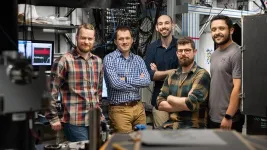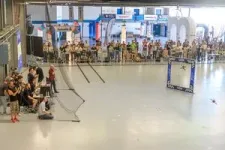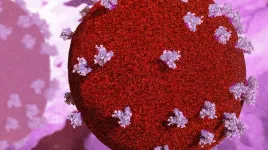(Press-News.org) Researchers have a new way to connect quantum devices over long distances, a necessary step toward allowing the technology to play a role in future communications systems.
While today’s classical data signals can get amplified across a city or an ocean, quantum signals cannot. They must be repeated in intervals — that is, stopped, copied and passed on by specialized machines called quantum repeaters. Many experts believe these quantum repeaters will play a key role in future communication networks, allowing enhanced security and enabling connections between remote quantum computers.
The Princeton study, published Aug. 30 in Nature, details the basis for a new approach to building quantum repeaters. It sends telecom-ready light emitted from a single ion implanted in a crystal. The effort was many years in the making, according to Jeff Thompson, the study’s principal author. The work combined advances in photonic design and materials science.
Other leading quantum repeater designs emit light in the visible spectrum, which degrades quickly over optical fiber and must be converted before traveling long distances. The new device is based on a single rare earth ion implanted in a host crystal. And because this ion emits light at an ideal infrared wavelength, it requires no such signal conversion, which can lead to simpler and more robust networks.
The device has two parts: a calcium tungstate crystal doped with just a handful of erbium ions, and a nanoscopic piece of silicon etched into a J-shaped channel. Pulsed with a special laser, the ion emits light up through the crystal. But the silicon piece, a whisp of a semiconductor stuck onto the top of the crystal, catches and guides individual photons out into the fiber optic cable.
Ideally, this photon would be encoded with information from the ion, Thompson said. Or more specifically, from a quantum property of the ion called spin. In a quantum repeater, collecting and interfering the signals from distant nodes would create entanglement between their spins, allowing end-to-end transmission of quantum states despite losses along the way.
Thompson’s team first started working with erbium ions several years before, but first versions used different crystals that harbored too much noise. In particular, this noise caused the frequency of the emitted photons to jump around randomly in a process known as spectral diffusion. This prevented the delicate quantum interference that is necessary to operate quantum networks. To solve this problem, his lab started working with Nathalie de Leon, associate professor of electrical and computer engineering, and Robert Cava, a leading solid-state materials scientist and Princeton’s Russell Wellman Moore Professor of Chemistry, to explore new materials that could host single erbium ions with much less noise.
They winnowed the list of candidate materials from hundreds of thousands down to a few hundred, then a couple dozen, then three. Each of the three finalists took half a year to test. The first material turned out to be not quite clear enough. The second caused the erbium to have poor quantum properties. But the third, the calcium tungstate, was just right.
To demonstrate that the new material is suitable for quantum networks, the researchers built an interferometer where photons randomly pass through one of two paths: a short path that is several feet long, or a long path that is 22 miles long (made of spooled optical fiber). Photons emitted from the ion can go on the long path or the short path, and about half the time, consecutive photons take opposite paths, and arrive at the output at the same time.
When such a collision occurs, quantum interference causes the photons to leave the output in pairs if and only if they are fundamentally indistinguishable – having the same shape and frequency. Otherwise, they leave the interferometer individually. By observing a strong suppression — up to 80 percent — of individual photons at the interferometer output, the team proved conclusively that the erbium ions in the new material emit indistinguishable photons. According to Salim Ourari, a graduate student who co-led the research, that puts the signal well above the hi-fi threshold.
While this work crosses an important threshold, additional work is required to improve the storage time of quantum states in the spin of the erbium ion. The team is currently working on making more highly refined calcium tungstate, with fewer impurities that disturb the quantum spin states.
The paper, “Indistinguishable telecom band photons from a single erbium ion in the solid state,” was published in the journal Nature with the support of the U.S. Department of Energy, Office of Science, National Quantum Information Science Research Centers, Co-design Center for Quantum Advantage (C2QA). In addition to Thompson, Cava and Ourari, authors include Łukasz Dusanowski, Sebastian P. Horvath, Mehmet T. Uysal, Christopher M. Phenicie, Paul Stevenson, Mouktik Raha, Songtao Chen and Nathalie de Leon. Ourari, Dusanowski, Horvarth and Uysal all contributed equally.
END
A simpler way to connect quantum computers
A new atomic device sends high-fidelity quantum information over fiber optic networks
2023-08-30
ELSE PRESS RELEASES FROM THIS DATE:
Parental incarceration increases cardiovascular risk in young adults
2023-08-30
Cardiovascular disease remains the leading cause of racial disparities in mortality between Black and white people in the United States. New research from the University of Chicago Medicine suggests that parental incarceration may be contributing to these health gaps.
According to the new study, people who experienced a parent or parental figure’s incarceration anytime before the age of 18 had higher levels of hypertension and coronary disease biomarkers than people whose parents were not incarcerated. These results indicate that mass incarceration may have transgenerational health consequences.
Adverse childhood experiences (ACEs) are difficult ...
Unveiling global warming’s impact on daily precipitation with deep learning
2023-08-30
A collaborative international research team led by Professor Yoo-Geun Ham from Chonnam National University and Professor Seung-Ki Min from Pohang University of Science and Technology (POSTECH) has made a discovery on the impact of global warming on global daily precipitation. Using a deep learning approach, they have unveiled a significant change in the characteristics of global daily precipitation for the first time. Their research findings were published on August 30 in the online version of Nature, the ...
Challenge accepted: High-speed AI drone overtakes world-champion drone racers
2023-08-30
Remember when IBM’s Deep Blue won against Gary Kasparov at chess in 1996, or Google’s AlphaGo crushed the top champion Lee Sedol at Go, a much more complex game, in 2016? These competitions where machines prevailed over human champions are key milestones in the history of artificial intelligence. Now a group of researchers from the University of Zurich and Intel has set a new milestone with the first autonomous system capable of beating human champions at a physical sport: drone racing.
The AI system, called Swift, won multiple races against three world-class champions in first-person view (FPV) ...
Could a cancer drug hold the key to a HIV cure?
2023-08-30
An existing blood cancer drug has shown promise in killing ‘silent’ HIV cells and delaying reinfections – a significant pre-clinical discovery that could lead to a future cure for the disease.
Hidden HIV cells, known as latent infection, are responsible for the virus permanently remaining in the body and cannot be treated by current therapy options. These hibernating, infected cells are the reason why people living with HIV require life-long treatment to suppress the virus.
Led by WEHI and The Peter Doherty Institute for Infection ...
Robustness of the world's skyscrapers stress-tested by Surrey model
2023-08-30
The safety of tall buildings in the world's cities, in the face of extreme external traumas like vehicle impacts, blasts or fires, has been tested using a model developed by structural engineers at the University of Surrey – with reassuring results.
Surrey's structural engineers partnered with industry experts to check and enhance the robustness of skyscrapers. Surrey's researchers collaborated with experts at the respected collective of architects, designers, engineers and planners, Skidmore, Owings & Merrill (SOM), famous for buildings like the Burj Khalifa, the world's tallest skyscraper, and the Sears ...
Inequities in cardiovascular care are putting older female’s heart health at risk
2023-08-30
Toronto, ON, August 30, 2023 – Higher stroke risk among females with atrial fibrillation may be related to sex-based disparities in cardiovascular care, according to a new study from Women’s College Hospital, the Peter Munk Cardiac Centre (PMCC) at University Health Network (UHN) and ICES.
Atrial fibrillation (AF) is a common type of irregular heart rhythm that is associated with a higher risk of stroke—after the age of 40, one in four strokes are caused by AF. Previous studies have found that female sex (assigned at birth) is a risk factor for AF-associated stroke. Recent research suggested that ...
Surprising study results: Students are bored during exams
2023-08-30
In the case of boredom, we think of many situations in life but intuitively not of exams. However, an international team of academics led by Thomas Götz from the University of Vienna has now studied exactly this phenomenon of test boredom for the first time and found remarkable results. According to the study, school students are actually very bored during exams. The study also showed that utter boredom has a negative effect on exam results. The research results have been published recently in the Journal of Educational Psychology.
Although boredom is currently a very intensively studied phenomenon, test boredom has so far been completely ignored ...
Study reveals important associations between gut microbiome and eczema in infancy
2023-08-30
Washington, D.C. – A new study has revealed important associations between the gut microbiome and eczema in infancy and has established the basis for the potential prevention and treatment of eczema via modulation of the gut microbiota. The study was published in mSystems, a journal of the American Society for Microbiology.
“The problem of eczema is increasing, and our study shows it could be a result of unwanted changes in the gut bacterial content. The first year of life could be a critical period to restore the gut bacteria to a more desirable composition,” said the study’s principal investigator ...
Adapting Ritalin® to tackle cocaine abuse
2023-08-30
Cocaine use continues to be a public health problem, yet despite concerted efforts, no drugs have been approved to resolve cocaine addiction. Research suggests that the attention-deficit/hyperactivity disorder drug methylphenidate (MPH; Ritalin®) could serve as a cocaine-replacement therapy, but clinical results have been mixed. Although several labs have produced MPH derivatives for testing, parts of the molecule remained chemically inaccessible. Now, researchers reporting in ACS Central Science have cleared that hurdle.
According to the Centers for Disease Control and Prevention, more than 5 million Americans ...
A new way to capture and recycle carbon dioxide from industrial emissions
2023-08-30
Carbon capture is a promising method to help slow climate change. With this approach, carbon dioxide (CO2) is trapped before it escapes into the atmosphere, but the process requires a large amount of energy and equipment. Now, researchers reporting in ACS Central Science have designed a capture system using an electrochemical cell that can easily grab and release CO2. The device operates at room temperature and requires less energy than conventional, amine-based carbon-capture systems.
Many industries are turning ...
LAST 30 PRESS RELEASES:
The impact of family dynamics on eating behaviour – how going home for Christmas can change how you eat
Tracing the quick synthesis of an industrially important catalyst
New software sheds light on cancer’s hidden genetic networks
UT Health San Antonio awarded $3 million in CPRIT grants to bolster cancer research and prevention efforts in South Texas
Third symposium spotlights global challenge of new contaminants in China’s fight against pollution
From straw to soil harmony: International team reveals how biochar supercharges carbon-smart farming
Myeloma: How AI is redrawing the map of cancer care
Manhattan E. Charurat, Ph.D., MHS invested as the Homer and Martha Gudelsky Distinguished Professor in Medicine at the University of Maryland School of Medicine
Insilico Medicine’s Pharma.AI Q4 Winter Launch Recap: Revolutionizing drug discovery with cutting-edge AI innovations, accelerating the path to pharmaceutical superintelligence
Nanoplastics have diet-dependent impacts on digestive system health
Brain neuron death occurs throughout life and increases with age, a natural human protein drug may halt neuron death in Alzheimer’s disease
SPIE and CLP announce the recipients of the 2025 Advanced Photonics Young Innovator Award
Lessons from the Caldor Fire’s Christmas Valley ‘Miracle’
Ant societies rose by trading individual protection for collective power
Research reveals how ancient viral DNA shapes early embryonic development
A molecular gatekeeper that controls protein synthesis
New ‘cloaking device’ concept to shield sensitive tech from magnetic fields
Researchers show impact of mountain building and climate change on alpine biodiversity
Study models the transition from Neanderthals to modern humans in Europe
University of Phoenix College of Doctoral Studies releases white paper on AI-driven skilling to reduce burnout and restore worker autonomy
AIs fail at the game of visual “telephone”
The levers for a sustainable food system
Potential changes in US homelessness by ending federal support for housing first programs
Vulnerability of large language models to prompt injection when providing medical advice
Researchers develop new system for high-energy-density, long-life, multi-electron transfer bromine-based flow batteries
Ending federal support for housing first programs could increase U.S. homelessness by 5% in one year, new JAMA study finds
New research uncovers molecular ‘safety switch’ shielding cancers from immune attack
Bacteria resisting viral infection can still sink carbon to ocean floor
Younger biological age may increase depression risk in older women during COVID-19
Bharat Innovates 2026 National Basecamp Showcases India’s Most Promising Deep-Tech Ventures
[Press-News.org] A simpler way to connect quantum computersA new atomic device sends high-fidelity quantum information over fiber optic networks






